
|
Sale 80
June Pre Long Beach Sale
| Lot |
Photo |
Description |
Realized |
Lot 898 |
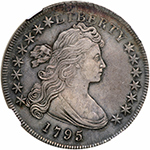 |
1795. Draped Set Left B-14, BB-51 Rarity 2. NGC graded AU-58. Nicely toned on both sides. Pop 14; 5 finer for the variety, 1 in 61, 2 in 62, 2 in 66.
Estimated Value $18,000 - 20,000.
View details and enlarged photos
| Realized
$21,738 |
Lot 899 |
 |
1795. Draped Set Left B-14, BB-51 Rarity 2. NGC graded AU-55. Lovely light golden toning. Pleasing original luster on exquisitely preserved surfaces, toned with a simple array of lighter to medium shade-lines across the obverse, more dabbled looking toning embraces the reverse. The reverse shows a wider range of luster than the obverse, but the visual impact is superb on both sides. Fully struck on both sides, as well, from centering dot to rims, just a tiny flat spot on the eagle's forward leg. A handsome, detailed, and nicely preserved 1795 Draped Bust Small Eagle dollar. The rims, outstanding. Nothing in the form of contact marks that we feel need describing, unless perhaps one wants to mention a microscopic tic on the eagle�s throat area. This beautifully toned specimen must rank among the most attractive AU55 1795 Draped Bust dollars on the market, a coin that would make any advanced collector deliriously happy.
Variety Notes: BB-51 represents the first variety of the new Draped Bust dollar designs coined during 1795. On the obverse, the portrait of Liberty is somewhat off-center to the left, leaving her lowest curl distant from the first star. Star one is nearer to the second curl from the bottom. The reverse displays a newly depicted eagle standing in the clouds, with an olive branch to its left and a palm branch on the right. This same reverse die, bearing lettering in a small font, went on to be re-used for coinage through the year 1798! Pop 10 finer, 8 finer for the variety .
Estimated Value $15,000 - 18,000.
View details and enlarged photos
| Realized
$15,863 |
Lot 900 |
 |
1796 Small Date Large Letters B-4, BB-61 Rarity 3. PCGS graded VF-25. Nice old time even gray toning. There is a field mark between the hair ribbon and stars 7-8, the only noticeable mark on an otherwise much better than average surface. Strong hair details.
This scarce Small Eagle variety combines an obverse that has a small, wide date with 96 close and 6 tipped to the left with raised "dot" or die flaw over the 1 in date and closer to bust, a tiny extra projection or flaw extending from the space at the bottom of star 11. This and the obverse used to strike BB-66 were the first two obverse dies cut in 1796, and have the lower right tip of the R in LIBERTY intact. The obverse die was used to strike 1796 BB-61 (early state) and BB-62 (late state).
Paired to it is Reverse "A" with large letters in the legend. Letters AMER appear crowded together and touch at the bases. Eight plain berries in the wreath with a berry under the first T in STATES. Two leaves beneath eagle's left wing, these having been added by hand in front of the cloud. There is a small defect in field attached to two denticles below (as made), and slightly left of the left ribbon end. This reverse punch is from the same hub used to create 1795 BB-51 and 52, but on 1796 BB-61 it was not as strongly impressed, the result being that the eagle's breast feathers are not as bold. Reverse die used to strike 1796 BB-61 only (PCGS # 6860) .
Estimated Value $3,800 - 4,000.
View details and enlarged photos
Check results on similar lots
| Realized
$4,113 |
Lot 901 |
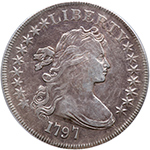 |
1797. 9 Stars Left, 7 Right, Large Letters. B-1, BB-73, Rarity 3 PCGS graded Genuine XF Details. Cleaning. Even light gray toning on both sides. Only 7,776 struck. Smooth surface and freedom from edge bumps, the devices are stronger than average for this often weak Draped Bust, Small Eagle date. Light milky gray color. Free of spotting and rough handling.
Henry DeSaussure, the Mint Director, responding to criticisms of the Robert Scot flowing hair design of 1794-5, had a new obverse made based upon a drawing by Gilbert Stuart, the prominent portrait artist whose Washington likeness appears on the $1 bill. It is believed the model for the obverse was Mrs. William Bingham, a famous belle of the day and friend of both Washington and Jefferson. The dies were done by Jacob Eckstein, a German-born specialist, in September to October 1795; he was probably responsible for the redesign of the reverse as well which was undertaken at the same time.
The revised reverse quite possibly was designed to allow fuller striking of both sides with the new obverse; the old reverse would have been so placed as to leave the eagle almost headless on most normal strikes.) The strikes with this combination were issued from 1795 to 1798 (PCGS # 6863) .
Estimated Value $2,000 - 2,200.
View details and enlarged photos
Check results on similar lots
| Realized
$3,525 |
Lot 902 |
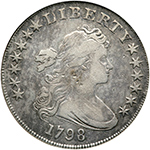 |
1798 Large Eagle B-13 BB-108 Rarity 2. ANACS graded VF-20. Light gray toning. Medium wide date nicely placed in the area provided. Die crack upward from right portion of L in LIBERTY. BB-108 is easily identified by a die flaw between a ray of star 13 and the bust. Among the stars on the left, 1-2, 2-3, and 5-6 are more widely spaced than others. On the right stars 8-9 are noticeably wider apart than are any others. A short crack, or flaw, extends into the field from a dentil opposite bust tip.
The use of this obverse die is especially interesting in that it was interrupted. This die was used first to strike examples of 1798 BB-108, then BB-109 dollars were struck, then additional BB-108 dollars were coined. Die state progressions provide the telltale evidence.
On the reverse, only 10 arrows. 5 small berries, with the 2 top ones closest together. A point of the leaf is under the left lower tip of I in AMERICA. The star distant from the eagle's beak. Arc star pattern. A die crack along right wing tip, top of AM to border above E. "This is a later state of the reverse that used to have 10 arrows and a headless stick (used to coin 1798 B13 107)," explains the Bowers Silver Dollar encyclopedia. "For the production of 1798 BB-108, the reverse die was relapped, removing the headless stick.".
Estimated Value $1,900 - 2,000.
View details and enlarged photos
| Unsold |
Lot 903 |
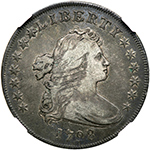 |
1798. Large Eagle B-15, BB-112 Rarity 3. NGC graded VF-25. Deeply toned and quite attractive, with medium gray color in the field offsetting the lighter "rubbed silver" color accenting the high points of the design. Arc star pattern on reverse. Wide date. Several hundred specimens of 1798 BB-112 exist, probably about 250 to 450, placing it in the medium range of rarity among varieties of this date. Most specimens are in grades up through VF and EF. AU or finer pieces are very rare.
Estimated Value $2,000 - 2,100.
View details and enlarged photos
| Unsold |
Lot 904 |
 |
1798 Large Eagle B-11, BB-111 Rarity 3. PCGS graded VF-20. Nice even gray toning, dove-color for the most part, meaning not too deep, not too light, but somewhere in-between. Normal surface wear for VF20 quality. Choice rims. Some weakening in the eagle and shield and a couple of the clouds above (PCGS # 6873) .
Estimated Value $1,900 - 2,000.
View details and enlarged photos
Check results on similar lots
| Realized
$1,939 |
Lot 905 |
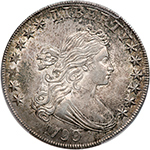 |
1799 B-16, BB-158 Rarity 2. PCGS graded MS-64. CAC Approved. A remarkable early Heraldic Eagle Dollar irrespective of type, date or die variety, this handsome 1799 Draped Bust shimmers with a hard, satiny sheen as the view rotates it under a light, admiring in the process its fine detail and incredible mint bloom. Much of the reverse is brilliant, and speckled in olive-russet and charcoal-gray patina generally, mainly confined to the periphery. The obverse is more extensively toned, although here too dappled olive-russet and charcoal-copper patina are mostly present around the periphery. We see some delicate champagne-pink undertoning throughout the obverse that is really not evident on the other side of the coin. Stars 3-4 on the obverse have the only noticeable lack of detail, leaving the remaining devices with bold-to-sharp definition. Much of the coin�s beauty and alluring eye-appeal result from a fairly well centered strike on both sides, giving the whole ensemble a balanced appearance; only in the 10-11 o'clock area on the reverse do the dentils become a bit tight.
Among the more plentiful die marriages of the 1799 Draped Bust Dollar, BB-158 is readily obtainable in all grades up to and including About Uncirculated. The variety remains rare in Mint State, however, the near-Gem we are offering here certainly qualifies for the upper reaches of "Condition Census." It also ranks among the finest-known survivors of the issue as a whole, perfectly enhancing its desirability for inclusion in the finest rare coin portfolio. One would hope for and expect that there are no conspicuous abrasions on either side, and this is the case. We are unable to offer any pedigree markers aside from the aforementioned pattern of toning. Perhaps a little toned spot below the eagle�s beak, along with the speckled toning on either side. Pop 10; 6 finer, 1 in 64+, 2 in 65, 1 in 65+, 2 in 66 (PCGS # 6878) .
Some events of the Year 1799, as gleaned from the Bowers-Borckhardt silver dollar encyclopedia: On December 14, 1799, George Washington died at Mount Vernon, his Virginia home. Four days later the news reached Philadelphia. In a speech before Congress, Henry Lee described the deceased as "First in war, first in peace, and first in the hearts of his countrymen." Early the following year, speeches, eulogies, and parades were given in Washington's honor, and medallic remembrances were produced, the most famous being the varieties of cent-sized tokens made in copper, white metal, silver, and gold by Jacob Perkins of Newburyport, Massachusetts, and bearing the inscription, HE IS IN GLORY, THE WORLD IN TEARS. The memory of the first president would endure, and as one medal noted, "time increases his fame."
A census conducted by Spanish authorities in lower Louisiana revealed that there were 42,375 inhabitants, two-thirds of whom were of European extraction. The Baltimore American became the first publication to record congressional debates and speeches in detail. In Dalton, Massachusetts, the Crane paper mill was established; it would later furnish sheets for the printing of bank notes and currency.
In England, chemist Humphry Davy inhaled nitrous oxide, or laughing gas, and reported that it made him insensitive to pain; the gas later came into use as an anesthetic. The first British income tax passed Parliament. In Egypt, Champollion discovered the Rosetta Stone, which had been carved with inscriptions in three different languages; when deciphered, it became the key to decoding ancient Egyptian writing.
Estimated Value $100,000 - 110,000.
View details and enlarged photos
Check results on similar lots
| Realized
$114,563 |
Lot 906 |
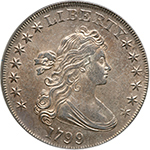 |
1799 B-10, BB-163 Rarity 2. PCGS graded MS-61. Frosty with a hint of light gold tone. Wonderful lustrous surfaces are flourishing with neutral gray-gold toning over residual silvery brilliance. Well struck for the date, with outstanding obverse details in the full stars, finely detailed hair curls on Liberty (including an unusually full "lovelock" curl on her neck which rarely strikes well on this issue; as for the reverse details all are present and accounted for, indeed without hesitation we can say "full" details. Fully struck coins of this date are rare due to the large size of the silver dollar planchets and the amount of force it took the press operator to swing the large screw press�s "boom" handle. What a lovely coin! Pop 14; 47 finer (PCGS # 6878) .
1799 BB-163 shares the spotlight with BB-166 as one of the two most plentiful varieties of the year and it happens to be one of the best made issues this year. The Bowers encyclopedia gives a number of 1,000 to 1,800 as the number extant. "Curiously, nearly all are in lower grade levels through VF, plus a few scattered EF and AU coins. The offering of a Mint State coin should be a major event (at least, once the rarity of such is widely known). This variety must have been well distributed in the channels of commerce, or there may be some other explanation why so few high-grade coins were saved.".
Estimated Value $20,000-UP.
View details and enlarged photos
Check results on similar lots
| Realized
$23,500 |
Lot 907 |
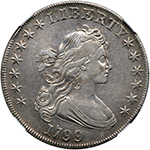 |
1799 B-17, BB-164 Rarity 2. NGC graded AU-50. A hint of light tone. Pop 3; 6 finer for the variety, 3 in 53, 1 in 55, 1 in 58, 1 in 64.
Estimated Value $6,000 - 6,500.
View details and enlarged photos
| Realized
$6,169 |
Lot 908 |
 |
1799 B-21, BB-169 Rarity 3. PCGS graded AU-53. Nice even toning on both sides (PCGS # 6878) .
Estimated Value $6,000 - 6,500.
View details and enlarged photos
Check results on similar lots
| Realized
$6,756 |
Lot 909 |
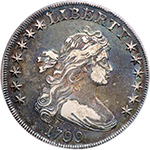 |
1799 B-12, BB-160 Rarity 3. PCGS graded EF-40. Lovely toning on both sides. A well preserved Draped Bust Silver Dollar! The well toned surfaces are deepest in the fields, then lighter on the high points where natural circulation wear provides contrast. It looks as though this coin was retrieved from circulation before very much abrasion took place, since much of the design remains. Well struck for the 1799 date and easily matching or surpassing others in this grade (PCGS # 6878) .
Estimated Value $3,800 - 4,000.
View details and enlarged photos
Check results on similar lots
| Realized
$3,878 |
Lot 910 |
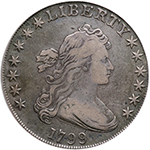 |
1799 B-11, BB-161 Rarity 3. PCGS graded VF-20. Even gray toning. A normal amount of wear consistent with the grade, the coin has plenty of appealing features that must have been the reason our consignor acquired it. Bidders will see to it that a firm bid is placed on the coin. A hearty reverse die was used to strike this and three other 1799 varieties. There are no berries. U in UNITED is defective at the upper left part, which is cut off, due to the employment of an imperfect punch. A point of the star touches the point of the lower part of the eagle's beak; a ray points to the left serif at the left side of U in PLURIBUS. The star under cloud 1 is noticeably smaller than any other. A in AMERICA rests on 4th feather. (This is the terminal state of this die, after having mated with four obverses including this one.) (PCGS # 6878) .
Estimated Value $1,900 - 2,000.
View details and enlarged photos
Check results on similar lots
| Realized
$1,939 |
Lot 911 |
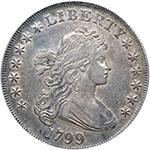 |
1799. B-5, BB-157, Rarity 2. PCGS graded Genuine, Smoothed - XF Details. Light gray toning. A smart-looking example in spite of the minor touch-up to fix a surface problem. Good transitional year to include in a Type Set as the Colonial era 18th century drew to a close and the pending industrial age growth century dawned (PCGS # 6878) .
Estimated Value $850 - 900.
View details and enlarged photos
Check results on similar lots
| Realized
$2,174 |
Lot 912 |
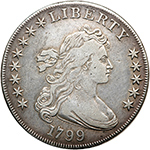 |
1799. B-23 BB-159. Rarity 4. 8 x 5 Stars VF30 Details. Antique silver grey color graces both sides of this pleasing example. Quite desirable. Popular Red Book variety with this unusual star arrangement on the obverse (PCGS # 40063) .
Estimated Value $1,600 - 1,800.
View details and enlarged photos
Check results on similar lots
| Realized
$940 |
Lot 913 |
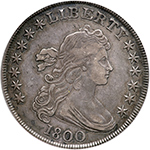 |
1800 B-8, BB-188 Rarity 4. PCGS graded VF-35. CAC Approved. Light gray toning on both sides. An extremely attractive coin for this conservative grade, the surfaces are plainly above-average while color (light to medium gray) is all original and the shade which collectors prefer, having encountered too many cleaned specimens "out there." Centers are strong on the obverse but slightly weaker on the reverse. This is often seen. Portions of E PLURIBUS UNUM are indistinct, and the eagle�s head and neck somewhat flat, although we must say that the shield lines are mainly intact. To reiterate, a highly commendable Draped Bust Dollar.
Die note: Bolender said this: "Look for the die 'dot' inside lower part of R, near the left upright, in LIBERTY." This easily distinguishes this die, which was also used for BB-189.
Three upper stars on right on reverse do not touch clouds. Three upper stars on left on reverse each have one point touching clouds. Leaf points slightly left of center of I in AMERICA. Star enters eagle's mouth, upper part of beak closing down on side of star point. Letter A just touches 3rd and 4th feathers. AME do not join each other. Very large berries. A over clouds 2 and 3. Tip of arrowhead under center of U in UNITED. Reverse die used to strike 1800 BB-188 only (PCGS # 6887) .
Estimated Value $2,500 - 2,700.
View details and enlarged photos
Check results on similar lots
| Realized
$3,231 |
Lot 914 |
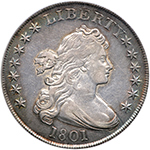 |
1801. B-2, BB-212, Rarity 3. PCGS graded EF-40. Nice blue and gold toning on the edges. Only 54,454 struck. Highly lustrous still within Liberty�s hair waves and largely smooth surfaced with splendid topmost highlights on both sides. All but fully struck for such an early issue, with just an insubstantial touch of weakness at the eagle�s head and neck feather which hardly matters at all. E PLURIBUS UNUM is complete and the ribbon on which it is inscribed nicely separated from the lower design. The coin has a fairly substantial advantage over 99% of similarly graded specimens that might compete with it for your attention and/or bid. Pop 1; 7 finer at PCGS for the variety. (PCGS # 40084) .
Historic note: "To the shores of Tripoli." There is at the moment a lot of discussion about undeclared wars. That is nothing new, however. America�s first such undeclared war took place in 1801, the year of this handsome Draped Bust silver dollar. Conflict with the North African port city of Tripoli began when the Pasha of Tripolitania cut down the flagpole at the U. S. Consulate, a major diplomatic slur, after the U. S. refused to pay tribute to pirates along the Barbary Coast. Later, on the night of February 16, 1804, Lieut. Stephen Decatur and his daredevil crew, with the full permission of President Thomas Jefferson, slipped aboard the captured American ship Philadelphia as it lay docked in Tripoli harbor, knifed the guards, set the ship afire by using gunpowder, and rowed safely away. Finally, in 1805, the U. S. consul in Tunis, William Eaton, collected a rabble army in Egypt-consisting of 38 Greeks, 300 Arabs, a dethroned pasha, and 7 marines under Lieut. Preston N. O'Bannon, and marched 600 miles across the desert to attack Tripoli from the rear. The phrase "To the shores of Tripoli" in the U.S. Marines' hymn refers to this incident.
Estimated Value $5,000 - 5,500.
View details and enlarged photos
Check results on similar lots
| Unsold |
Lot 915 |
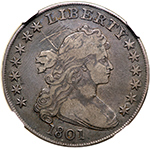 |
1801. B-4 BB-214, Rarity 4. NGC graded VF Details, Obverse Scratches. Nice even old time gray toning on both sides. Bust Dollar coinage, having been quite high in 1798 through 1800, declined markedly in 1801-03. The Mint's bullion depositors, primarily banks, tended to prefer half dollars and since coinage in the early 19th century was "to order" a noticeable increase in half dollar coinage occurred. President Jefferson eventually called for the Mint to cease striking silver dollars, since they were exported and melted almost as soon as they were paid out by the Treasury Department.
Estimated Value $800 - 900.
View details and enlarged photos
| Realized
$1,058 |
Lot 916 |
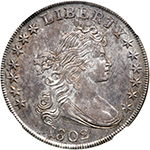 |
1802. Narrow Date B-6, BB-241 Rarity 1. NGC graded MS-62. Lovely light golden toning on both sides. The 1802 BB-241 dollar is the one Heraldic Eagle dollar of 1798-1803 most often encountered, with many fine examples known, this attractive MS62 with its shimmering luster among the better survivors. The variety is identified by the missing right foot of T in LIBERTY. This is the only 1802 Normal Date variety with that feature.
A boldly defined coin like this, in lovely MS62 condition is the exception. We expect that all will agree it is an aesthetically attractive early dollar with sharp details on the design elements on both sides. The surfaces seem to dance from side to side with boiling silvery color, and quite lustrous beneath the lightly dappled toning. Both sides are equal in fresh appearance and extensive mint frostiness. In one way, the luster sets the beauty. In another, the precision strike on every device of this coin completes the picture. The devices were struck with such force and energy by the dies that all design elements show boldly, which is a marvel when one remembers that this is a Silver Dollar minted in 1802. Bold strikes are quite uncommon in this early period in U.S. Mint history. Struck at the celebrated First U.S. Mint (1792-1833).
Pop 2; 6 finer for the variety, 5 in 63, 1 in 65.
Estimated Value $30,000 - 35,000.
View details and enlarged photos
| Realized
$37,600 |
Lot 917 |
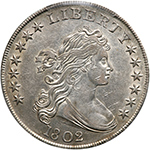 |
1802. Narrow Date B-6, BB-241 Rarity 1. PCGS graded AU-53. Frosty and mostly untoned. This attractive, well struck coin has a few light marks across the portrait an in the obverse field. Luster is present in most areas, indicating a very short time spent in circulation. We see frost around the stars and date, under LIBERTY and around, within, and upon her profile. The reverse shows even more frostiness, possibly because this side of the coin has greater detail that protects the delicate field surface. Probably a good many 1802 Bust Dollars are not nearly as well struck as this handsome piece, with no suggestion or even a whisper of weakness at the hair curls or scroll with E PLURIBUS UNUM. Rims are outstanding as well. This variety noted for its late intermediate die state. The reverse has a noticeable break along the inner dentils from D of UNITED to A of STATES, with another starting above the (O)F and continuing across the tops of AM to the rim. Pop 27; 71 finer (PCGS # 6895) .
Estimated Value $8,000 - 8,500.
View details and enlarged photos
Check results on similar lots
| Realized
$9,106 |
|
|